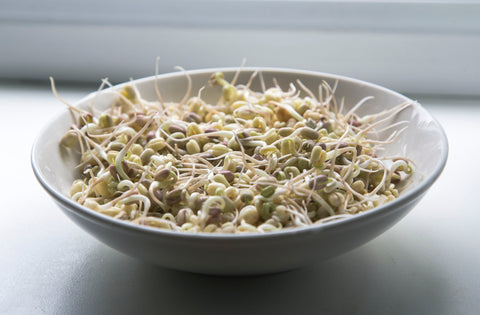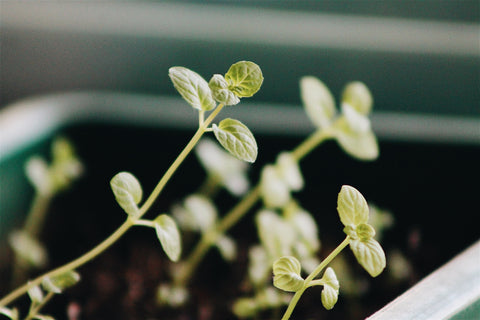
March 31, 2020 3 min read 1 Comment
Well, the short answer is that it’s healthier for you! Soaking and sprouting release nutrients and make grains, beans, and seeds (and even some nuts!) more easily digestible.
Sprouted foods have been steadily gaining in popularity as more and more people become aware of the tremendous benefits. Interestingly, the value of simply soaking these foods has been overlooked. Read on to learn more about these amazingly simple, but essential steps, to getting the most out of your grains, seeds, beans & nuts.

As we all know, much of our knowledge of healthy eating was forgotten with the industrialization of our food. One important step that was lost along the way was soaking. You see, these natural foods come with enzyme inhibitors and phytic acid which both do a beautiful job of preserving them until they are ready to germinate in nature but keep our bodies from being able to access and easily digest them as food. Soaking gets rid of these and frees up those nutrients.
Even though ‘sprouting’ is the buzz word today, soaking is actually more important, and, ready for it? You should ALWAYS soak your grains and beans, always, always, whether you plan to eat them raw or cook them. The importance of soaking beans is more commonly known but it is just as important to soak your grains (it even helps seeds too!). We cannot stress this enough. The primary reason behind this is to neutralize and remove the phytic acid.
Phytic acid is a natural, protective toxin that is both friend and foe. It is the key to keeping our dry foods preserved for so long in our pantries but when it comes time to eat those foods, phytic acid keeps our bodies from digesting and accessing all the wonderful nutrients available in grains, seeds, and nuts. Specifically, it inhibits enzyme functions and the absorption of minerals (particularly zinc, magnesium, iron & calcium, and isn’t it interesting that these minerals are so often noted as common deficiencies?). Phytic acid inhibits the absorption by binding with these minerals. This means that consuming unsoaked grains (or beans) over long periods of time can actually bring about further depletions of these important minerals in your body.
The good news is that simply soaking for 12-24 hours will get rid of the phytic acid and start the germination process. Although invisible to the naked eye at this point, the most important part of the germination process is the chemical changes happening within the grain (or seed or nut) not the actual seedling growth itself.

Germination causes the starches to change to simple sugars, neutralizes the effect of the phytic acid, and activates nutrients and enzymes. All of these changes make it much easier for your body to digest them, thus increasing the number of nutrients you can absorb. There is even some further benefit with wheat grains, where the changes caused by soaking can reduce potential allergic reactions to gluten and make them more easily tolerated by those with gluten sensitivities.
Add a dash of vinegar, lemon juice, whey, or even sauerkraut juice to the water to further help break up and remove the phytic acid. The key to soaking your grains is to dispose of the water and rinse them very well before using them. You may also find that the grain actually tastes and cooks better!
In the case of seeds and nuts, soaking helps here too. If you like your nuts and seeds dry, a dehydrator is an easy way to get them back to that state after soaking. Also, fermenting and toasting can go some way in helping to neutralize the phytic acid and release nutrients.
If you want to keep going and grow sprouts, you just need to place the grain or seed into a colander after you’ve soaked, rinsed and drained, be sure they can drain well and cover with muslin. For more detailed information on this step see our blog on 'Sprouting Sunflower Seeds'or keep an eye out for our upcoming blog ‘The Essentials of Sprouting’.
More and more people are catching onto the huge improvements to nutrients and digestibility that sprouting can add. Now let’s get everyone soaking too!
Related Blogs:
Thanks for reading this Be Still Farms Blog article. To sign up for more news/articles and/or recipes, click here. For more about us, click here. To shop our certified organic products, click here.
Please comment and share and we look forward to serving you in the future!
Comments will be approved before showing up.

April 22, 2024 3 min read
This article traces the journey of organic kasha, also known as toasted buckwheat groats, from its cultivation as a seed to its role in sustainable agriculture and its culinary uses on the dining table. Highlighting the eco-friendly farming practices and nutritional benefits, it delves into how kasha supports both personal health and environmental sustainability. Rich in protein, fiber, and essential nutrients, kasha is celebrated for its unique flavor and versatility in dishes ranging from traditional Eastern European recipes to modern health-conscious meals.

April 17, 2024 3 min read

April 10, 2024 2 min read
© 2024 Be Still Farms- Real, Fine Organics.
Privacy | Terms | Refund Policy | Organic Certification

Tasha Crowder
April 20, 2020
What is the process for sprouting grains and then using those for instance hard bread green already sprouted in bread, Do you have to dehydrate the sprouted grain in order for it to grind properly?